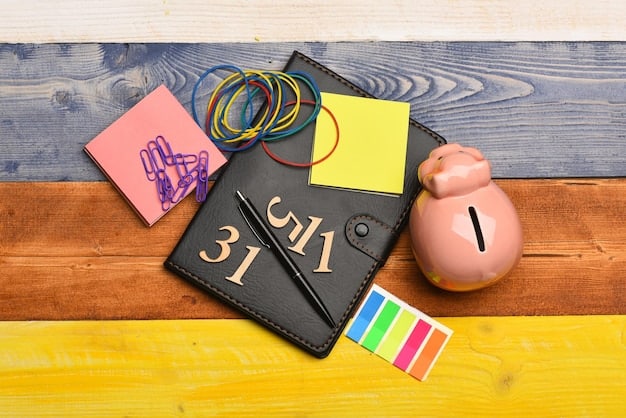Create a Realistic Budget When Living Paycheck to Paycheck

Creating a realistic budget when living paycheck to paycheck involves tracking income and expenses, prioritizing essential needs, setting achievable financial goals, and finding creative ways to save and reduce debt.
Anúncios
Living paycheck to paycheck can feel like a constant financial tightrope walk, but it doesn’t have to be a permanent state. Learning how to create a realistic budget when you’re living paycheck to paycheck is the first step toward taking control of your finances and building a more secure future.
Understanding Your Current Financial Situation
Before you can start building a budget, it’s crucial to understand exactly where your money is going. This involves gathering information about your income and expenses to get a clear picture of your current financial health.
Calculate Your Income
Start by calculating your net income – the amount you take home after taxes and other deductions. This is the foundation of your budget.
Track Your Expenses
Track every dollar you spend for at least one month. Use budgeting apps, spreadsheets, or a notebook to record your expenses. Categorize your spending to identify where your money is going.
- Use budgeting apps like Mint, YNAB (You Need a Budget), or Personal Capital to automatically track your spending.
- Create a simple spreadsheet with categories like housing, food, transportation, utilities, and entertainment.
- Carry a small notebook to jot down every purchase you make.
Understanding your current financial situation is like taking a snapshot of your finances. Once you have this information, you can begin to identify areas where you can make changes and start building a budget that works for you.
Setting Realistic Financial Goals
Now that you have a clear picture of your income and expenses, it’s time to set some financial goals. These goals will help you stay motivated and focused as you work toward improving your financial situation.
Short-Term Goals
Short-term goals are achievable within a few months to a year. These could include paying off a small debt, saving for an emergency fund, or reducing your monthly expenses.
Long-Term Goals
Long-term goals take more time to achieve, typically several years or even decades. These might include saving for retirement, buying a home, or paying off student loans.
- Pay off a credit card with a high interest rate.
- Save $500 for a starter emergency fund.
- Reduce your grocery bill by $50 per month.
Setting realistic financial goals provides a clear roadmap for your budgeting efforts. Breaking down large goals into smaller, manageable steps makes the process less overwhelming and keeps you motivated along the way.
Prioritizing Needs Versus Wants
One of the most important aspects of creating a realistic budget is distinguishing between needs and wants. Needs are essential for survival and well-being, while wants are non-essential expenses that can be reduced or eliminated.
Identifying Needs
Needs typically include housing, food, transportation, utilities, and healthcare. These are the expenses you must cover to maintain a basic standard of living.
Categorizing Wants
Wants include things like entertainment, dining out, new clothes, and subscriptions. While these items can enhance your quality of life, they are not essential for survival.
- Housing: Rent or mortgage, property taxes, and homeowners insurance.
- Food: Groceries for healthy meals.
- Transportation: Gas, car insurance, and public transportation costs.
Prioritizing needs over wants is a fundamental step in creating a budget that aligns with your financial goals. By carefully evaluating your expenses and making conscious choices, you can free up more money to put toward your priorities.
Creating a Detailed Budget Plan
With a clear understanding of your income, expenses, and financial goals, you can now create a detailed budget plan. This plan will serve as your roadmap for managing your money effectively.
The 50/30/20 Rule
The 50/30/20 rule allocates 50% of your income to needs, 30% to wants, and 20% to savings and debt repayment. This is a simple and effective way to balance your budget.
Zero-Based Budgeting
Zero-based budgeting requires you to allocate every dollar of your income to a specific purpose, ensuring that your income minus your expenses equals zero.
- Allocate 50% of your net income to needs like rent, utilities, and groceries.
- Dedicate 30% to wants such as dining out and entertainment.
- Use the remaining 20% for savings and debt repayment.
Finding Ways to Reduce Expenses
One of the most effective strategies for creating a realistic budget when living paycheck to paycheck is to find ways to reduce your expenses. This can free up more money for savings and debt repayment.
Lowering Housing Costs
Explore options for lowering your housing costs, such as downsizing to a smaller apartment or finding a roommate to share expenses.
Reducing Transportation Expenses
Consider using public transportation, biking, or walking instead of driving. Look for ways to save on gas, car insurance, and maintenance.
- Cook more meals at home instead of eating out.
- Cancel unused subscriptions and memberships.
- Shop around for cheaper insurance rates.
Finding ways to reduce expenses can significantly improve your financial situation. By making small changes to your spending habits, you can free up more money for your goals.
Tracking and Adjusting Your Budget Regularly
Creating a budget is not a one-time task; it’s an ongoing process that requires regular tracking and adjustments. This ensures that your budget remains aligned with your financial goals and current circumstances.
Monitoring Your Spending
Regularly monitor your spending to ensure you’re staying within your budget. Use budgeting apps, spreadsheets, or a notebook to track your expenses and identify any areas where you may be overspending.
Making Necessary Adjustments
Be prepared to make adjustments to your budget as needed. Life events like job changes, unexpected expenses, or changes in income may require you to revise your budget.
- Review your budget weekly or monthly to identify trends and areas for improvement.
- Adjust your budget based on your progress toward your financial goals.
- Seek advice from a financial advisor if you’re struggling to manage your budget.
Tracking and adjusting your budget regularly is essential for achieving long-term financial success. By staying on top of your finances and making necessary changes, you can ensure your budget remains effective and helps you reach your goals.
| Key Point | Brief Description |
|---|---|
| 💰Track Expenses | Monitor where your money goes each month. |
| 🎯Set Goals | Establish short and long-term financial objectives. |
| ✂️ Reduce Spending | Cut unnecessary costs to save more money. |
| 📊 Adjust Budget | Adapt your budget to changing circumstances. |
FAQ
▼
The first step is to calculate your net income, which is the amount you take home after taxes. Next, track your expenses for a month to understand where your money is going.
▼
Needs are essential expenses like housing, food, and transportation. Wants are non-essential items like entertainment and dining out. Prioritize needs over wants to save money.
▼
The 50/30/20 rule allocates 50% of your income to needs, 30% to wants, and 20% to savings and debt repayment. It’s a simple way to balance your income.
▼
You can reduce expenses by cooking at home, canceling unused subscriptions, shopping for cheaper insurance, and using public transportation. Small changes can make a big difference.
▼
Tracking your budget regularly helps you stay on track, identify areas where you’re overspending, and make necessary adjustments. It ensures your budget remains effective.
Conclusion
Creating a realistic budget when living paycheck to paycheck is a journey that requires commitment and consistent effort. By understanding your financial situation, setting realistic goals, prioritizing needs over wants, and regularly tracking your progress, you can take control of your finances and build a more secure future.







